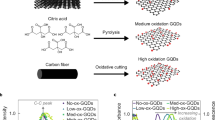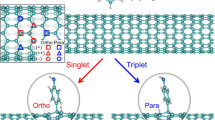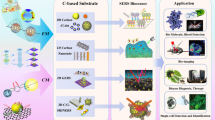Abstract
Single-wall carbon nanotubes (SWCNTs) are used in diverse applications that require chemical tailoring of the SWCNT surface, including optical sensing, imaging, targeted drug delivery and single-photon generation. SWCNTs have been noncovalently modified with (bio)polymers to preserve their intrinsic near-infrared fluorescence. However, demanding applications (e.g., requiring stability in biological fluids) would benefit from a stable covalent linkage between the SWCNT and the functional unit (e.g., antibody, fluorophore, drug). Here we present how to use diazonium salt chemistry to introduce sp3 quantum defects in the SWCNT carbon lattice to serve as handles for conjugation while preserving near-infrared fluorescence. In this protocol, we describe the straightforward, stable (covalent), highly versatile and scalable functionalization of SWCNTs with biomolecules such as peptides and proteins to yield near-infrared fluorescent SWCNT bioconjugates. We provide a step-by-step procedure covering SWCNT dispersion, quantum defect incorporation, bioconjugation, in situ peptide synthesis on SWCNTs, and characterization, which can be completed in 5–7 d.
This is a preview of subscription content, access via your institution
Access options
Access Nature and 54 other Nature Portfolio journals
Get Nature+, our best-value online-access subscription
$29.99 / 30 days
cancel any time
Subscribe to this journal
Receive 12 print issues and online access
$259.00 per year
only $21.58 per issue
Buy this article
- Purchase on Springer Link
- Instant access to full article PDF
Prices may be subject to local taxes which are calculated during checkout









Similar content being viewed by others
Data availability
The authors declare that the main data discussed in this protocol are available in the supporting primary research paper35. The raw datasets are available for research purposes from the corresponding authors upon reasonable request and are publicly available in the repository https://doi.org/10.6084/m9.figshare.16595093.
References
Hayashi, T. et al. Smallest freestanding single-walled carbon nanotube. Nano Lett. 3, 887–889 (2003).
O’Connell, M. J. et al. Band gap fluorescence from individual single-walled carbon nanotubes. Science 297, 593–596 (2002).
Welsher, K. et al. A route to brightly fluorescent carbon nanotubes for near-infrared imaging in mice. Nat. Nanotechnol. 4, 773–780 (2009).
Liu, Z., Tabakman, S. M., Chen, Z. & Dai, H. Preparation of carbon nanotube bioconjugates for biomedical applications. Nat. Protoc. 4, 1372–1381 (2009).
Galassi, T. V. et al. An optical nanoreporter of endolysosomal lipid accumulation reveals enduring effects of diet on hepatic macrophages in vivo. Sci. Transl. Med. 10, eaar2680 (2018).
Barone, P. W., Baik, S., Heller, D. A. & Strano, M. S. Near-infrared optical sensors based on single-walled carbon nanotubes. Nat. Mater. 4, 86–92 (2005).
Gillen, A. J. & Boghossian, A. A. Non-covalent methods of engineering optical sensors based on single-walled carbon nanotubes. Front. Chem. 7, 13713–13793 (2019).
Mann, F. A., Lv, Z., Grosshans, J., Opazo, F. & Kruss, S. Nanobody conjugated nanotubes for targeted near‐infrared in vivo imaging and sensing. Angew. Chem. Int. Ed. 58, 11469–11473 (2019).
Mann, F. A., Herrmann, N., Meyer, D. & Kruss, S. Tuning selectivity of fluorescent carbon nanotube-based neurotransmitter sensors. Sensors 17, 1521 (2017).
Dinarvand, M. et al. Near-infrared imaging of serotonin release from cells with fluorescent nanosensors. Nano Lett. 19, 6604–6611 (2019).
Kruss, S. et al. High-resolution imaging of cellular dopamine efflux using a fluorescent nanosensor array. Proc. Natl Acad. Sci. USA 114, 1789–1794 (2017).
Kruss, S. et al. Neurotransmitter detection using corona phase molecular recognition on fluorescent single-walled carbon nanotube sensors. J. Am. Chem. Soc. 136, 713–724 (2014).
Wu, H. et al. Monitoring plant health with near-infrared fluorescent H2O2 nanosensors. Nano Lett. 20, 2432–2442 (2020).
Bisker, G. et al. Protein-targeted corona phase molecular recognition. Nat. Commun. 7, 1–14 (2016).
Williams, R. M., Lee, C. & Heller, D. A. A fluorescent carbon nanotube sensor detects the metastatic prostate cancer biomarker uPA. ACS Sens. 3, 1838–1845 (2018).
Holzinger, M. et al. Sidewall functionalization of carbon nanotubes. Angew. Chem. Int. Ed. 40, 4002–4005 (2001).
Huang, W. J. et al. Attaching proteins to carbon nanotubes via diimide-activated amidation. Nano Lett. 2, 311–314 (2002).
Pantarotto, D., Briand, J.-P., Prato, M. & Bianco, A. Translocation of bioactive peptides across cell membranes by carbon nanotubes [supplementary information]. Chem. Commun. 1, 16–17 (2004).
Ghosh, S., Bachilo, S. M., Simonette, R. A., Beckingham, K. M. & Weisman, R. B. Oxygen doping modifies near-infrared band gaps in fluorescent single-walled carbon nanotubes. Science 330, 1656–1659 (2010).
Miyauchi, Y. et al. Brightening of excitons in carbon nanotubes on dimensionality modification. Nat. Photonics 7, 715–719 (2013).
Piao, Y. M. et al. Brightening of carbon nanotube photoluminescence through the incorporation of sp3 defects. Nat. Chem. 5, 840–845 (2013).
Kwon, H. et al. Molecularly tunable fluorescent quantum defects. J. Am. Chem. Soc. 138, 6878–6885 (2016).
He, X. et al. Carbon nanotubes as emerging quantum-light sources. Nat. Mater. 17, 663–670 (2018).
He, X. et al. Tunable room-temperature single-photon emission at telecom wavelengths from sp3 defects in carbon nanotubes. Nat. Photonics 11, 577–582 (2017).
Hertel, T., Himmelein, S., Ackermann, T., Stich, D. & Ќ, J. C. Diffusion limited photoluminescence quantum yields in 1-D semiconductors. ACS Nano 4, 7161–7168 (2010).
Danné, N. et al. Ultrashort carbon nanotubes that fluoresce brightly in the near-infrared. ACS Nano 12, 6059–6065 (2018).
Kwon, H. et al. Optical probing of local pH and temperature in complex fluids with covalently functionalized, semiconducting carbon nanotubes. J. Phys. Chem. C. 119, 3733–3739 (2015).
Shiraki, T., Onitsuka, H., Shiraishi, T. & Nakashima, N. Near infrared photoluminescence modulation of single-walled carbon nanotubes based on a molecular recognition approach. Chem. Commun. 52, 12972–12975 (2016).
Setaro, A. et al. Preserving π-conjugation in covalently functionalized carbon nanotubes for optoelectronic applications. Nat. Commun. 8, 14281 (2017).
Chio, L., Pinals, R. L., Murali, A., Goh, N. S. & Landry, M. P. Covalent surface modification effects on single-walled carbon nanotubes for targeted sensing and optical imaging. Adv. Funct. Mater. 30, 1910556 (2020).
Gifford, B. J., Kilina, S., Htoon, H., Doorn, S. K. & Tretiak, S. Controlling defect-state photophysics in covalently functionalized single-walled carbon nanotubes. Acc. Chem. Res. 53, 1791–1801 (2020).
Mandal, A. K. et al. Fluorescent sp3 defect-tailored carbon nanotubes enable NIR-II single particle imaging in live brain slices at ultra-low excitation doses. Sci. Rep. 10, 5286 (2020).
Shiraki, T., Miyauchi, Y., Matsuda, K. & Nakashima, N. Carbon nanotube photoluminescence modulation by local chemical and supramolecular chemical functionalization. Acc. Chem. Res. 53, 1846–1859 (2020).
Clément, P. et al. A one-step chemical strategy for the formation of carbon nanotube junctions in aqueous solution: reaction of DNA-wrapped carbon nanotubes with diazonium salts. Chempluschem 84, 1235–1238 (2019).
Mann, F. A., Herrmann, N., Opazo, F. & Kruss, S. Quantum defects as a toolbox for the covalent functionalization of carbon nanotubes with peptides and proteins. Angew. Chem. Int. Ed. Engl. https://doi.org/10.1002/anie.202003825 (2020).
Brozena, A. H., Kim, M., Powell, L. R. & Wang, Y. Controlling the optical properties of carbon nanotubes with organic colour-centre quantum defects. Nat. Rev. Chem. 3, 375–392 (2019).
Chiu, C. F., Saidi, W. A., Kagan, V. E. & Star, A. Defect-induced near-infrared photoluminescence of single-walled carbon nanotubes treated with polyunsaturated fatty acids. J. Am. Chem. Soc. 139, 4859–4865 (2017).
Georgakilas, V. et al. Amino acid functionalisation of water soluble carbon nanotubes. Chem. Commun. 0, 3050–3051 (2002).
Pantarotto, D. et al. Functionalized carbon nanotubes for plasmid DNA gene delivery. Angew. Chem. Int. Ed. 43, 5242–5246 (2004).
Wu, W. et al. Targeted delivery of amphotericin B to cells by using functionalized carbon nanotubes. Angew. Chem. Int. Ed. 44, 6358–6362 (2005).
Prato, M. & Kostarelos, K. Functionalized carbon nanotubes in drug design and discovery. Acc. Chem. Res. 41, 60–68 (2008).
Hirsch, A. Functionalization of single-walled carbon nanotubes. Angew. Chem. Int. Ed. Engl. 41, 1853–1859 (2002).
Helma, J., Cardoso, M. C., Muyldermans, S. & Leonhardt, H. Nanobodies and recombinant binders in cell biology. J. Cell Biol. 209, 633–644 (2015).
Hamers-Casterman, C. et al. Naturally occurring antibodies devoid of light chains. Nature 363, 446–448 (1993).
Spreinat, A. et al. Quantum defects in fluorescent carbon nanotubes for sensing and mechanistic studies. J. Phys. Chem. C. 125, 18341–18351 (2021).
Nißler, R. et al. Remote near infrared identification of pathogens with multiplexed nanosensors. Nat. Commun. 11, 5995 (2020).
Powell, L. R., Piao, Y. & Wang, Y. Optical excitation of carbon nanotubes drives localized diazonium reactions. J. Phys. Chem. Lett. 7, 3690–3694 (2016).
Luo, H. B. et al. One-pot, large-scale synthesis of organic color center-tailored semiconducting carbon nanotubes. ACS Nano 13, 8417–8424 (2019).
Kim, M. et al. Mapping structure–property relationships of organic color centers. Chem 4, 2180–2191 (2018).
Dong, L., Witkowski, C. M., Craig, M. M., Greenwade, M. M. & Joseph, K. L. Cytotoxicity effects of different surfactant molecules conjugated to carbon nanotubes on human astrocytoma cells. Nanoscale Res. Lett. 4, 1517–1523 (2009).
Li, Y. et al. Fluorescent ultrashort nanotubes from defect-induced chemical cutting. Chem. Mater. 31, 4536–4544 (2019).
Zhang, K., Xu, X.-H. & Qing, F.-L. Copper-promoted Ritter-type trifluoroethoxylation of (hetero)arenediazonium tetrafluoroborates: a method for the preparation of trifluoroethyl imidates. Eur. J. Org. Chem. 2016, 5088–5090 (2016).
Schöppler, F. et al. Molar extinction coefficient of single-wall carbon nanotubes. J. Phys. Chem. C. 115, 14682–14686 (2011).
Ravasco, J. M. J. M., Faustino, H., Trindade, A. & Gois, P. M. P. Bioconjugation with maleimides: a useful tool for chemical biology. Chem. Eur. J. 25, 43–59 (2019).
Kumar, A., Biebuyck, H. A. & Whitesides, G. M. Patterning self-assembled monolayers: applications in materials science. Langmuir 10, 1498–1511 (1994).
Harper, J. C., Polsky, R., Wheeler, D. R. & Brozik, S. M. Maleimide-activated aryl diazonium salts for electrode surface functionalization with biological and redox-active molecules. Langmuir 24, 2206–2211 (2008).
Acknowledgements
This work was funded by the Deutsche Forschungsgemeinschaft (DFG, German Research Foundation) under Germany’s Excellence Strategy–EXC 2033–390677874–RESOLV. This project was supported by the VW Foundation.
Author information
Authors and Affiliations
Contributions
S.K. and F.A.M. designed and conceived the project. S.K. coordinated the project. N.H. performed MalPh diazonium salt synthesis, NMR/MS analysis and initial experiments, and optimized the conditions for MalPh-defect incorporation. F.A.M. performed AFM experiments, synthesized the Fmoc-Phe diazonium salt with N.H., optimized the conditions for Fmoc-Phe defect incorporation, performed the nanobody conjugation and validation experiments, synthesized multicolor SWCNTs, SWCNT-R6 and performed the 96-well SWCNT–peptide synthesis as well as the subsequent characterization. F.A.M., P.G., N.H. and S.K wrote the manuscript.
Corresponding author
Ethics declarations
Competing interests
The authors declare no competing interests.
Peer review
Peer review information
Nature Protocols thanks Hyejin Kwon and YuHuang Wang for their contribution to the peer review of this work.
Additional information
Publisher’s note Springer Nature remains neutral with regard to jurisdictional claims in published maps and institutional affiliations.
Related links
Key references using this protocol
Mann, F. A. et al. Angew. Chem. Int. Ed. Engl. 59,17732–17738 (2020): https://doi.org/10.1002/anie.202003825
Spreinat, A. et al. J. Phys. Chem. C 125, 18341–18351 (2021): https://doi.org/10.1021/acs.jpcc.1c05432
Supplementary information
Supplementary Information
Supplementary Data 1.
Rights and permissions
About this article
Cite this article
Mann, F.A., Galonska, P., Herrmann, N. et al. Quantum defects as versatile anchors for carbon nanotube functionalization. Nat Protoc 17, 727–747 (2022). https://doi.org/10.1038/s41596-021-00663-6
Received:
Accepted:
Published:
Issue Date:
DOI: https://doi.org/10.1038/s41596-021-00663-6
This article is cited by
-
Micro-engineering and nano-engineering approaches to investigate tumour ecosystems
Nature Reviews Cancer (2023)
-
Human and environmental safety of carbon nanotubes across their life cycle
Nature Reviews Materials (2023)
-
Full-Color Tunable and Highly Fire-Retardant Colored Carbon Fibers
Advanced Fiber Materials (2023)
Comments
By submitting a comment you agree to abide by our Terms and Community Guidelines. If you find something abusive or that does not comply with our terms or guidelines please flag it as inappropriate.



